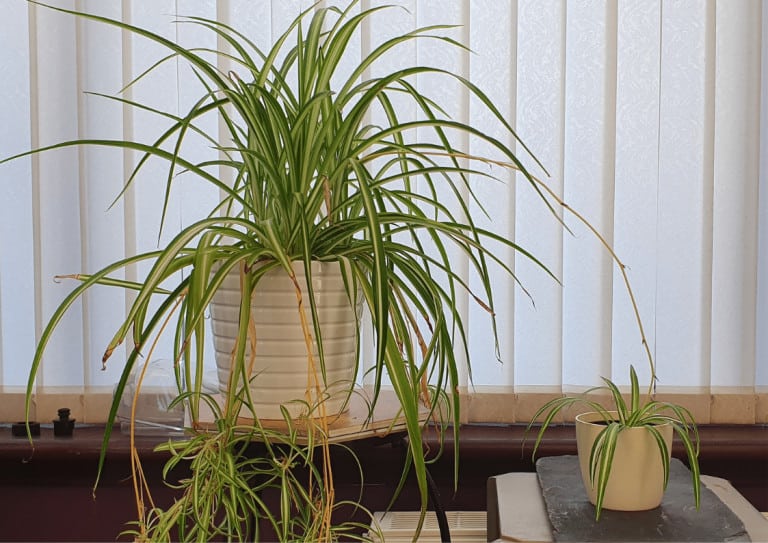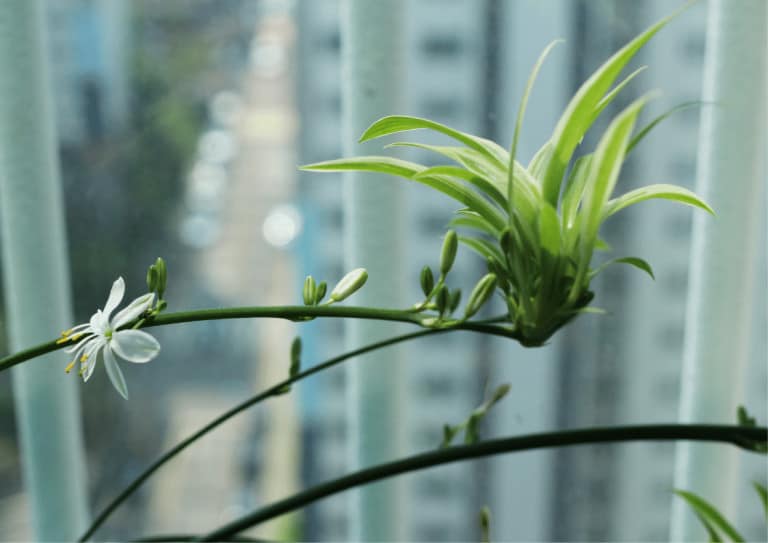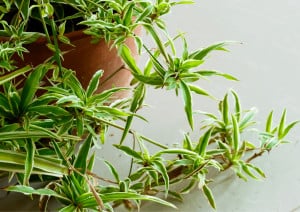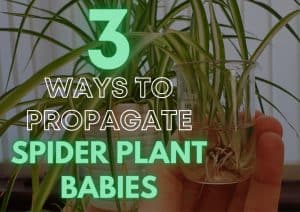When Do Spider Plants Have Spider Babies?
-
Chris Dosser
- February 2, 2022
If you buy something using the retail links in our articles, sometimes we earn a small affiliate commission. This does not impact the products we recommend.
Every new Spider plant parent anxiously awaits the arrival of their first baby spider plants – otherwise known as spiderettes. Spider plants are easy to grow and low maintenance, but their real treasure is the endless baby plants it provides.
Spider plants cannot reproduce until they are fully grown, which is usually when a plant reaches 1-2 years of age. Once it is mature, it will automatically start producing spiderettes provided it has access to plenty of indirect sunlight and a warm moist environment similar to their natural tropical and subtropical habitats.
Besides being mature enough to produce baby plants, a few specific things must happen to ensure your plant will make healthy offspring. The healthier a mature spider plant is, the easier and faster it will produce its spiderettes.
If you already have spiderettes growing on your plants you might want a little advice on when might be the right time to cut them off.

When will my spider plant be ready to have babies?
When you see your plant blooming, it’s time to look for spiderettes.
When the spider plant is old enough to reproduce, it will grow long, green-yellow runners with white flowers. The flowers are small and short-lived, and if you aren’t paying attention, they can be easy to miss. The baby spider plants will arrive when the flowers start to fade. The spider plant gets its name because the baby plants cascade and hang off the mother like baby spiders on the web.
Spider plants need plenty of light and warm weather to bloom and produce new baby plants. They will not bloom and produce offshoots in the cooler months. If your plant is healthy and at least one year of age, you can expect to see new baby plants during the warm seasons.
What does a spider plant need to create baby plants?
Spider plants are one of the easiest houseplants to take care of and grow. They can live for a long time, even with neglect. However, if you want to make sure your plant reproduces, it’s essential to meet its needs. A few specific preconditions must happen to ensure your plant can make plenty of healthy baby spider plants.
Even if a spider plant is mature enough, it won’t reproduce if it is not healthy or missing requirements critical to its best health. The needs of a spider plant are basic and include four main fundamentals to ensure a thriving plant. They need proper water, lighting, humidity, and fertilization.
Let’s take a closer look at the four main fundamentals for a thriving and reproducing plant:
Water: For the spider plant to produce offshoots, it needs to have the proper moisture level. Wait for the soil to be dry to the touch, water well, and ensure adequate drainage – even when using terracotta pots.
It is vital not to let the plant sit in excess water; the soil should entirely absorb the water.
Light: A spider plant requires lots of natural indirect light. They will survive in lower light conditions, but the plants must have year-round sunshine to reproduce. The plant needs to receive abundant indirect light for optimal reproduction, even in winter.
Plants convert carbon dioxide and water into oxygen and sugars, and reproducing requires lots of stored energy. It is essential to ensure the light is indirect in the hot summer months. Direct sunlight will scorch and burn the leaves and impede the reproduction process.
Our Favorite Spider Plants And Supplies On Etsy
Humidity: Spider plants will survive in a more arid environment. However, keeping them in warmer, moist air ensures reproduction success. Misting with water will help create a humid and tropical-like climate for your plant. The best temperature for a thriving plant is between 70-80 degrees, but Spider plants are adaptable and will survive if the temperature remains between 60-80 degrees.
Fertilization: Plant food is not required to grow a healthy spider plant. However, if you want to offer optimal growing conditions for a thriving and reproducing plant, fertilize with plant food only once a month during the growing season. Spider plants bloom and produce offshoots in the spring and summer months, so only give it plant food during this time. Fall and winter, the cooler months of the year, are the seasons the plant rests and restores to prepare for blooming and reproducing in the spring.

What if my mature spider plant isn’t producing spider babies?
Suppose your Spider plant is not producing tiny white blooms or offshoots, and you have no spiderettes.
In that case, your plant is probably missing out on a central element of care. Spider plants are low maintenance and can survive and grow in less than optimal conditions. While their easy to care for nature makes them popular, it can also be deceiving.
Just because your plant looks healthy doesn’t mean it can or will reproduce. It might be missing some of the required elements that allow it to store enough energy to make baby plants. Let’s take a further look at what may be preventing your plant from propagating.
A common myth about a spider plant that doesn't produce offshoots is that it must be a male plant and that only female plants can reproduce and bloom. Spider plants are asexual, which means they are neither male nor female but have all elements needed for reproduction in one plant.
Suppose your plant isn't blooming or making babies. In that case, it's not because it is male but more likely to do with an imbalance in any of the four main fundamentals plants require: water, light, humidity, and fertilization.
Troubleshoot water: An over or under-watered plant will not produce babies. If there is not enough water, the plant will not have the nutrients or energy to create offshoots. If there is too much water, the plant might get soggy roots, which impair the ability of the plant to move nutrients into the plant’s leaves.
Troubleshoot light: The most common reason a plant doesn’t reproduce is that it does not receive enough light. A plant that stays in a low-light environment will still do well, but it will not be able to gather and store enough energy during the year to make baby plants in the spring.
The solution is to give your plant bright yet indirect sunlight during daylight hours. It might take a full year for your mature plant to store enough energy from light to produce spiderettes, so be patient and wait for spring to roll around again.
Troubleshoot humidity: Proper humidity is necessary for a healthy plant to reproduce. If the air is too cold, the plant will not make baby plants. Keeping your plant in one location or at one temperature is also essential.
Changing the environment to a colder temperature can cause it to go into a more dormant state and not have the energy needed for reproduction. Temperatures less than 70 degrees might prevent offspring from developing.
Troubleshoot fertilizer: Getting the plant food right can be tricky. Not using plant food might keep your plant from reproducing because it doesn’t have enough nutrients. Still, overfeeding can make it too acidic to reproduce. A good rule of thumb is to fertilize only once a month.
Final thoughts
With a bit of patience and attention, you can have spiderettes overflowing your planters in no time.
To summarize and provide a take home message, your spider plant will begin to produce babies once it has reached at least one year of age, and its fundamental needs to reproduce (water, high exposure to indirect light, high humidity and warm growing environment) are met.

Chris Dosser
Co-Founder of Eden Indoors
Chris is a self-taught horticulturist with over a decade of experience caring for houseplants and creating lush, thriving indoor oases. He specializes in Monstera, and by self admission has a serious problem with buying and propagating rare indoor plants!
Similar Posts
Should I Cut The Babies Off My Spider Plant?
Will spider plant babies or the mother plant suffer if spiderettes remain attached for too long? Is there any benefit to cutting them off? Answers here.
3 Ways To Propagate Spider Plant Babies
Our adult spider plant has produced so many offsets that we had the chance to test several methods of propagating spider plant babies.



